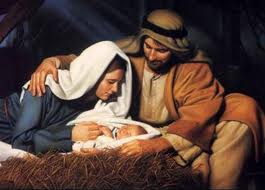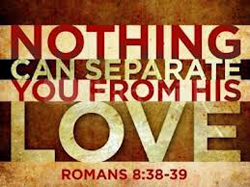A Christian understanding of Incarnation
Posted on 25 December 2012, 14:07
When I was British Chaplain in Gothenburg, Sweden, every fortnight I took a religious studies class in the English School. The school had pupils from upwards of sixty nationalities, and the children were Catholics, Protestants, from Islam, Buddhists, Hindus and Jews. We found that all faiths had a lot in common: belief in a Creator who had a purpose for our lives, that we should pray for guidance, for each other, and for those in need, and that ideally we should love and look after others, regardless of race or belief. We of course had other beliefs that divided us, but so much more that united us.

With regard to the question of whether the Divine could be made flesh, or be incarnated, not all religions agreed. But as I am a Christian, and this is Christmas Day, I would like to pray for Peace on Earth and Good Will to all people, and for all who read these words.
And I would like to present a Christian understanding of Incarnation.
Readers will be very familiar with the Christmas story, the birth of the baby Jesus in the stable in Bethlehem where God is seen as incarnate, made flesh, having a human body in Jesus.
I do believe that it would be true to say that Jesus was God incarnate, but that we would need to say a lot of other true things at the same time if we are to see things in a proper light.
All these true things need to be said together: The picture comes to mind of a great diamond, beautifully cut with many facets.
Each facet gives us a way of understanding how God can become incarnate. Each facet gives a limited picture, and can be a little misleading if you don’t remember the other facets. Just saying that God was incarnate in the baby Jesus, would not be reasonable.
In Liturgical churches such as the Catholics and Anglicans, we have the Christmas story. But then in Epiphany we hear of Jesus being baptised in the river Jordan, and the Holy Spirit descending like a dove from heaven, and filling Jesus with an especial awareness of God in his life. Then we have a period of hearing the teachings of Jesus about the Kingdom of Heaven, emphasising that not only he, but that all of us are children of God, that we are God’s children too. In other words God (whatever meaning we may give to that word) is incarnate in each of us. Jesus teaches us to pray, “Our Father in Heaven, hallowed be your name.”
I do remember the sterile and fruitless arguments I had about the doctrine of the Holy Trinity. Father, Son and Holy Spirit, three in one. I was told that it was a mystery, but that I must believe it. To help me understand it better I was told about St Patrick’s picture of the shamrock, a kind of three-leaf clover. Three in one, see? But a shamrock didn’t quite do the job of bringing me into a close awareness of Spirit. It brought me more into the spirit of useless disputation.
But it began to have strong meaning for me when I reminded myself that we are all sons and daughters of God, that the space between God and us is tissue thin, and that he is somehow in intimate connection with our minds, because we can pray to God, and receive guidance from God, just as the Jews before the time of Jesus had been able to do, and indeed praying people throughout the world had been able to do.

There is no separation between the deepest aspect of ourselves and our God, and there never has been, even though our wayward physical minds have tended be “away in a far country wasting our lives in riotous living” like the Prodigal Son of Jesus’ parable.
Part of what the life and death and resurrection of Jesus did, was to remind us that the Father was there to be returned to, and that all that we needed to do was to come to him and to receive his welcoming arms. Often we “Prodigal” children have to experience and suffer much before we return to the comfort and love of the Father.
St Paul spoke of the Father in whom we live and move and have our being. We have no reality other than that we live and move and have our being in the Father, in God. But, to recognise where we are and what we are part of, we have to die to selfishness, and self-centredness
St John’s Gospel Chapter 14:20 has the words of Jesus, “On that day you will realize that I am in my Father, and you are in me, and I am in you”.
When like the Prodigal Son, we come to our senses, we realise that we are in the Father and the Father in us, and that we are doing this with the inspiration of Christ.
So what are the incarnation facets of this great diamond that I was imagining?
I would treat as the first facet, the assertion that in what we call God, we live and move and have our being.
Then I would remind myself that in this life I am a spiritual being and as such not separated from Spirit, and if I surrender my self-centredness and am ready to be an agent of Spirit, I am like the sheep that hears the voice of its Shepherd, and can be herded into safety. I would need to remind myself that I am also a physical being with a physical mind, like the goat that often strays.
Then I would look to that birth that we celebrate on Christmas Day and celebrate the coming into the world of one who shows in his life, teaching, death and resurrection demonstrates what it means to be in perfect harmony with God.
A fellow child of God who gives each one of us a vision, indeed an inspirational relationship, whereby each of us can cease to be Prodigal Sons and Daughters, and return to the Father.
The child who was born on that day, (as he did in his parable of the Good Heathen Foreigner, or the Good Samaritan,) showed us that the way to union with the Father, was through love of neighbour, whatever the religion, nationality, sex, or status in life may be.
And although this Christmas Day I am writing wearing my “Christian” hat, I can think back to my class in Gothenburg, and remind myself how these insights are not confined to Christianity.
The philosopher Alfred North Whitehead proclaimed that the world lives by the incarnation of God. Whitehead asserted that God is present in every moment of experience as the source of possibilities and the energy to embody these possibilities in everyday life. Accordingly, we are all, in varying degrees, incarnations of divine wisdom and creativity. The greater openness toward God’s presence in our lives, the more God can be present, guiding, energizing, and inspiring our lives. Jesus’ uniqueness is not to be found in an absolute discontinuity between God’s presence in his life and God’s presence in our lives, but in the nature and intensity of God’s presence in Jesus’ life
Michael Cocks edits the journal, Ground of Faith.
Afterlife Teaching From Stephen the Martyr by Michael Cocks is published by White Crow Books and available from Amazon and other bookstores.
Paperback Kindle

January 7
|